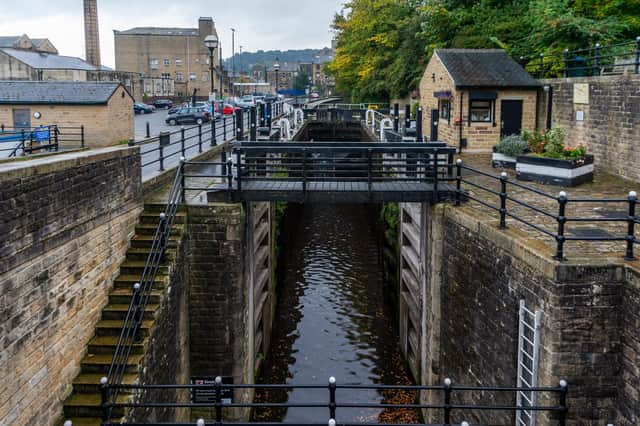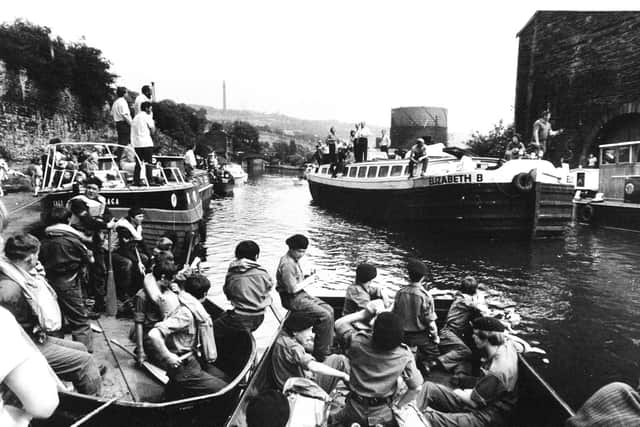From gas-lit textile mills to Happy Valley, Sowerby Bridge is a town with a pioneering spirit


a long, colourful and hugely significant industrial history, its position – nestled in some of the most stunning countryside in West Yorkshire – and today it’s a bustling place with great shops, pubs and restaurants.
There’s a touch of glamour too – in the 1970s it had close associations with some of the top European fashion houses and in recent years it has had a starring role on the small screen. Add a Brontë family link into the mix and it’s not hard to understand why people are drawn there.
Advertisement
Hide AdAdvertisement
Hide AdThe town was originally a fording point over the once much-wider River Calder where it joins the River Ryburn; it takes its name from the historic bridge which spans the river in the town centre.


The textile and engineering industry grew up around the bridge and by the mid-19th century had become the beating heart of the Calder Valley. I recently undertook map-maker Christopher Goddard’s Sowerby Bridge Industrial Heritage Walk (an enjoyable six miles set out in an illustrated pamphlet), on which you can see some of the oldest mill complexes in the county.
Textile production in Calderdale dates back to around 1150 with cropper’s shears depicted on a grave cover at Halifax Minster. By 1500, Halifax was the largest kersey-making district in Yorkshire. Weavers made this robust woollen cloth in their own homes; it kept out the cold and wet and was used for Navy sailors’ jackets and army uniforms.
The first textile mill in the country to be gas-lit was at Henry Lodge’s Willow Hall Mills in Sowerby Bridge. The woollen, worsted, cotton and carpet mills in the town were supported by the likes of tanneries, iron works and makers of steam engines, brass foundries, stone quarries and bobbin works.
Advertisement
Hide AdAdvertisement
Hide AdEngineering pioneer Timothy Bates established Bank Foundry in the late 18th century under the name of Pollit & Wigzell, which patented a compact stationary steam engine for marine use. Between 1892 and 1930, the business grew to be one of the largest of its kind in Yorkshire, employing over 400 men and building around 1,000 steam engines for the large home market and to be exported to India, Japan and New Zealand.
The British textile industry is inextricably linked with French couture – Chanel sourced her fabrics almost exclusively from Yorkshire, Cumbria and Scotland. Asquith Bottom Mill was an extensive mill complex owned by the Edleston family who specialised in pure camel hair and alpaca clothes, and in the 1970s supplied top European fashion houses with high-class mohair and cashmere accessories; clients included Dior, Aquascutum, Jaeger and Hermes.
The town is also home to Ackley Bridge, the acclaimed Channel 4 drama following the merger of two schools in a segregated white and Pakistani community.
Multi-award-winning writer and director Sally Wainwright grew up in Sowerby Bridge and not unsurprisingly she has chosen the town as a location – in 2007 her ITV drama Dead Clever was set here, though her depiction of it in Happy Valley didn’t exactly put it in a positive light. But more recently scenes from Gentleman Jack were filmed at Haugh End House, where Anne Lister was a regular visitor.
Advertisement
Hide AdAdvertisement
Hide AdThe Grade II-listed property was built in the 1760s and it is thought to be the work of architect John Carr, of York, who designed Harewood House.
The interiors feature moulded panelling and Ionic columns, along with decorative ceilings, cornices and friezes said to be by the York School of Plasterers.
In the mid-1800s, Branwell Brontë was the “assistant clerk in charge” at the station at Sowerby Bridge; he was there just under a year before he got another job up the road at Luddenden station but could be found most afternoons holding court in the Lord Nelson Tavern.
He was fired in March 1842 because of a “deficit in station accounts”, which is thought to have been more to do with his drinking rather than having his fingers in the till. In 1846 he put an ad in the Halifax Guardian asking for a job that would take him abroad but it wasn’t to be; he died in 1848 aged 31 from consumption.
Advertisement
Hide AdAdvertisement
Hide AdThe ancient custom of rushbearing, the annual ceremony of taking rushes to churches for covering the floors throughout winter, still takes place in Sowerby Bridge over the first weekend of September. Each year, in late summer, the old and rotten rushes were cleared out and new ones taken to the churches. These days it’s an excuse for celebration involving revelry, music, dancing and a bit of a pub crawl.
There’s a historic pub by the canal, the Puzzle Hall Inn, originally a “dwelling house” which dates back to the early 17th century – it wasn’t until 1905 before its doors opened for the sale of beer brewed by the redoubtable Mrs Lydia Platt. In subsequent years it became a vibrant live music venue, winning a listing in The Times’ Top 10 Small Jazz Venues in the UK. It recently reopened and is thriving as a community pub.
Sowerby Bridge Grammar School produced a number of noteworthy folk – along with Sally Wainwright, Roger Hargreaves, creator of Mr Men, was a pupil too. I wonder if either of them was taught by the world-renowned artist Peter Brook who was the art master for 20 years?
Writer and poet Glyn Hughes lived at Mill Bank on the edge of Sowerby Bridge, in a terrace house which he rebuilt stone by stone.
Advertisement
Hide AdAdvertisement
Hide AdIt features prominently in Millstone Grit, his account of moving to Calderdale, which will soon be re-issued with a foreword by award-winning Calderdale writer Benjamin Myers.
The paths and walkways that cut through the lush, wooded slopes of the Ryburn Valley that surround Sowerby Bridge are worth exploring; drink in the history and absorb the character of a town which is too often overlooked.
